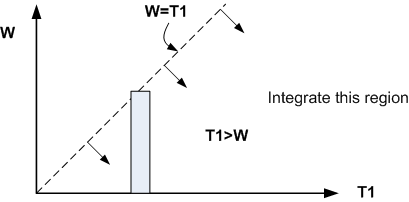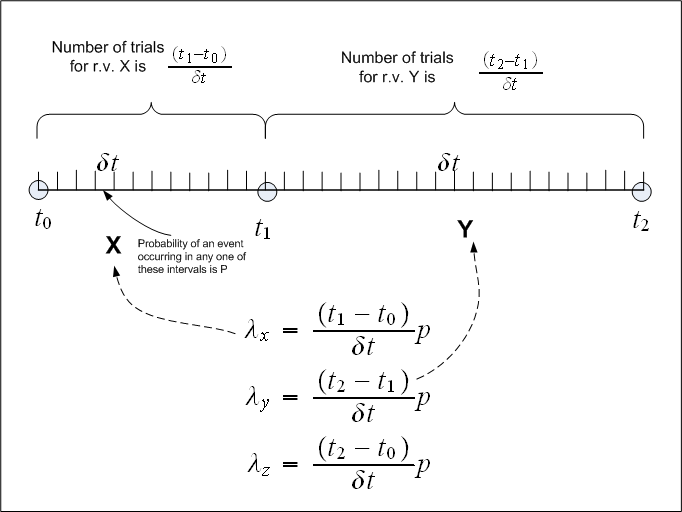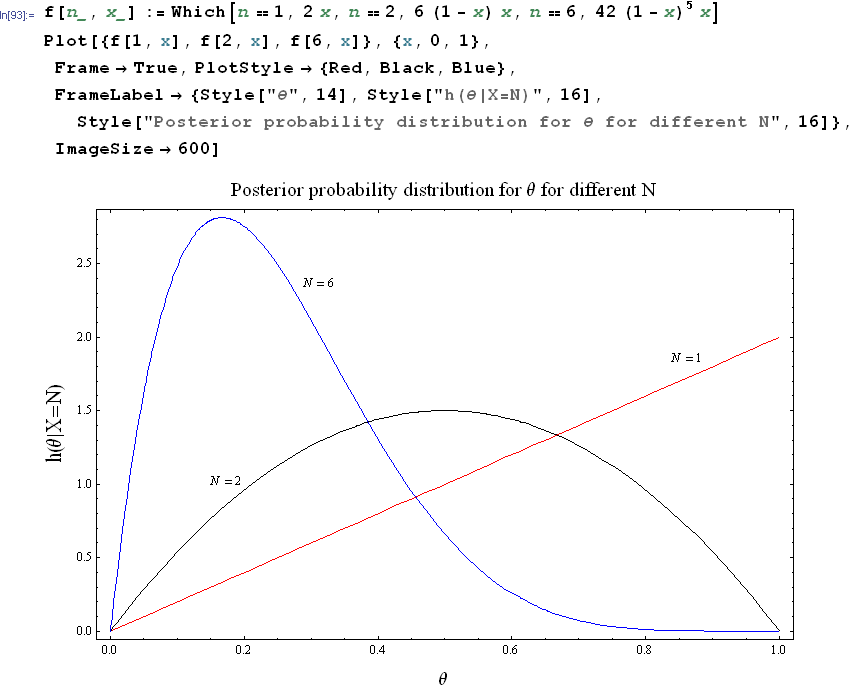

(a)Problem review:
is a random variable and
is a random variable, where
and
and
can be thought of as the failure rate for each respective component.
is the lifetime of
component
. Hence
means to ask for the probability of the first component to have a lifetime of
given that the failure rate of this kind of components is
solution:
Now we know that
Looking at the following diagram to help determine the region to integrate:

Hence
But since then the joint density is the product of the marginal densities.
Hence
Therefore
We take since we expect the lifetime to go to zero eventually. Also this is a requirement for the
integrals to not diverge.
Hence the above becomes
Hence
(b)
Hence
Hence
(c)Need to find which is the same as
, hence this is the same as part(a) but
replace
by
as show in the following diagram

Hence
Hence
Then

Problem review: Poisson probability density is a discrete probability function (We normally call
it the probability mass function ). This means the random variable is a discrete random
variable.
The random variable in this case is the number of success in
trials where the probability of success
in each one trial is
and the trials are independent from each others. The difference between
Poisson and Binomial is that in Poisson we are looking at the problem as
becomes very large and
becomes very small in such a way that the product
goes to a fixed value which is called
, the Poisson parameter. And then we write
where
The
following diagram illustrates this problem, showing the three r.v. we need to analyze and the time
line.

But what is "trials" in this problem? If we divide the time line itself into very small time intervals then
the number of time intervals is the number of trials, and we assume that at most one event will occur in this
time interval (since it is too small). The probability
of event occurring in this
is the same in the interval
and in the interval
. Now let us find
for
and
and
based on this. Since
where
is the number of trials, then for
we have
where we divided the time interval
by the time width
to obtain the number of time slots for
. We do the same for
and obtain that
Similarly, , hence

Let us refer to the random variable as
and the r.v.
as
and the r.v.
as
The problem is then asking to find and to identify
To help in the solution, we first draw a diagram to make it more clear.
We take to the same for the
random variables
.
But is the same as
hence
Now r.v.
, since the number of events in
is independent from the number of events that
could occur in
.
Given this, we can now write the joint probability of as the product of the marginal probabilities.
Hence the numerator in the above can be rewritten and we obtain
|
| (1) |
Now since each of the above is a Poisson process, then
Hence (1) becomes
|
| (2) |
Hence
But we found that , hence the exponential term above vanish and we get
Let , then
hence the last line above can be written
as
But this is a Binomial with parameters , hence

part (a)
Let the probability of getting heads, be the specific value that the random number
can
take.
Let be the probability density of
, which we are told to be
, and let
be the
probability mass function of the random variable
where
is the number of times until a head first comes
up.
is then a geometric random variable with parameter
, hence
The posterior density of given N is then
But
and since
Hence
|
| (1) |
But is a random continuous variable from
, so how to evaluate the above? I can evaluate the
above for different values of
on the real line from
, and the more values I take between
the more
accurate
will become.
Part(b)
First let me evaluate eq (1) for
For
For
For
We can use integration by parts for the denominator, where , when we do this we
obtain
Now we plot the above 3 cases on the same plot:

What the above plot is saying is the following:
If it takes 'longer' to see a head comes up (), then the coin is taken as biased towards a tail, and the
probability of getting a head becomes smaller, this is why we see that the most likely probability in this
case to be around
(looking at the N=6 curve). We say that based on the observation of
, then the coin has a higher probability of having its probability of getting a head to be about
than any other value. (The area around
is larger than any other area for the same
)
Now, when , i.e. we flipped the coin 2 times, and got a head on the second time, then we see from
the
curve that the coin has a most likelihood of having a probability of getting a head to be
0.5
This is what we would expect, since in an unbiased coin, the probability of getting a head is , and hence
with a fair coin, we expect to see a head half of the times it is flipped, and since we flipped 2 times, and saw
a head the second time, this posterior probability has its most likely value to be around .5 as
well.
When , this says that we got a head in the first time we flipped the coin. We see that the posterior
probability of getting a head now has it maximum around 1. This means the posterior probability is saying this
coin is biased towards a head.
The above is a method to estimate the probability distribution of the probability itself of getting a head based on the observed events and based on the prior known probability of getting a head. Hence the events observed allow us to estimate the probability of getting a head. Hence the posterior probability is conditioned on each event as in this problem.